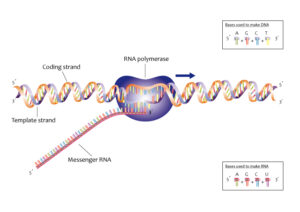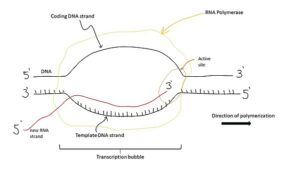DNA transcription is the method of getting the segment of DNA copied into RNA with having the process segmented.
The very method of getting the DNA codes coped into RNA and also for further carrying to the new model is transcription. The inclusion of DNA transcription diagram consist of the steps involved in the process being initiation, elongation and the termination.
The segments of the DNA that are to be transcribed in the molecules of RNA are able to have proteins encoded within them and are said to make messenger RNA. The rest of the DNA pieces are made to copy RNA and are called the non-coding ones. It is mostly the work of RNA needed here.
The general number of the messenger RNA is more than usually 10 times the actual tissue of the ncRNA and is valid for all cells despite the genomic percentage to be less than two and can also be converted to messenger RNA. The genome of mammals can have themselves converted actively along with the major part being 80.
It is not just in DNA but also the RNA where it used up base pairs for the nucleotides as the complementary code. At the time for transcription, a sequence of DNA is read by any of the RNA polymerase that gets to make a complementary, antiparallel RNA strand called the primary transcript. This method does allow involvement of quite a lot of steps.
Transcription is actually one of the basic methods that happen in the genome. It is the method of converting DNA to RNA. It refers to the first phase of central dogma with transcribing bits of RNA to specific areas of RNA. The most places for its act are the one that codes for proteins. There are places where an entire host is seen.

DNA Transcription–Wikipedia
Steps shown in the DNA transcription Diagram
There are quite a few steps in the process of DNA transcription involved along with involvement of few enzymes as well.
There is many function of the DNA that gets involved Initiation considering it as the first step. It is followed by elongation termination, 5’ Capping, polyadenylation and splicing. There are six of the steps shown in the DNA transcription diagram.
DNA transcription is the method by which any genetic data inside the DNA which is re written for the messenger RNA. There is a messenger RNA that stays inside the nucleus where it acts as a base for this process of DNA. By having the control over the making of messenger RNA inside the nucleus, the cell gets to regulate the rate of genes being expressed.
There is a split in the process of transcription and is done in three vital phases. These are the base steps seen in DNA termination. They are-
Initiation
It is the first step at where the very first nucleotides in the chain of RNA are made to synthesize. Transcription results in an RNA complement.
It is a step of multiple processes that begins when the RNAP holoenzyme links with the template of DNA and ends while the core polymerase escapes at the promoter after the first approximately synthesis on the nine types of nucleotides.
The entire method of DNA transcription is made to get catalysed by an enzyme called the RNA polymerase that links and makes itself mobile with the molecule of DNA till it gets seen by a sequence of promoter. This part of the DNA shows the beginning area of the method and there is possibility of much sequence of promoters here. As a result, transcription has a lower copying fidelity than DNA replication.
The factors of this method are the proteins that actually get to control the rate of this process and then link with the promoter sequence along with the RNA polymerase. After it linking with the promoter chain, the enzyme of RNA polymerase unwinds a segment of DNA that helps in getting the DNA strand exposed. Transcription has some proofreading mechanisms, but they are fewer and less effective than the controls for copying DNA.
DNA transcription is a method in which all genetic data within DNA is transcribed into messenger RNA. There is a messenger RNA remaining inside the nucleus that serves as the basis for this DNA process. By controlling messenger RNA production within the nucleus, cells can regulate the rate of gene expression.

Initiation–Wikipedia
Elongation
There are the presences of two strands of DNA that are seen and used for the process of DNA transcription.
One of the two strands of DNA or the template strand is actually read in the way of 3’ to 5’ path and thus it provides the strand of template of the new made molecule of messenger RNA. The other strand available is called the coding strand.
The reference of both of the strands of DNA is this as for the purpose being the base sequence is said to be identical that is referred to synthesize the messenger RNA except for getting the thiamine base replaced with the uracil. The bases can be added by the three prime way and in 5’ to 3’ path.
The enzyme of RNA polymerase uses the inside ribonulcleotide to make a new messenger RNA strand. It is done by getting the making of the bonds called phosphodiester bond catalyzed in between the places ribonucleotides that are adjacent. It follows the rule of complementary base paring being adenine with uracil, thymine to adenine, cytosine to guanine and vice versa.
Termination
The method of elongation takes place till the enzyme for RNA polymerase encounters a message for it to stop.
During this phase, the process of transcription stops the sequencing and here the entire method comes to a halt and the RNA polymerase enzyme gets to release the RNA template.
The very way of getting the process of RNA transcription terminated is called the termination. It happens only one time and at the very point when the polymerase gets to transcribe the sequence of the DNA called the terminator. The same for terminating is seen at the end of any gene that is used and can work in much number of paths.
If the stretch of DNA is transcribed into an RNA molecule that encodes a protein, the RNA is termed messenger RNA (mRNA); the mRNA, in turn, serves as a template for the protein’s synthesis through translation. Other stretches of DNA may be transcribed into small non-coding RNAs such as microRNA, transfer RNA (tRNA), small nucleolar RNA (snoRNA), small nuclear RNA (snRNA), or enzymatic RNA molecules called ribozymes as well as larger non-coding RNAs such as ribosomal RNA (rRNA), and long non-coding RNA (lncRNA).
During transcription, the DNA sequence is read by any RNA polymerase that receives a complementary antiparallel RNA strand called the primary transcript. This method allows you to use a few steps. Here the ribosome is made to reach the stop codon to get the process to an end. There are three codons to stop- UAA, UGA and UAG. Overall, RNA helps synthesize, regulate, and process proteins; it therefore plays a fundamental role in performing functions within a cell.

Transcription bubble–Wikipedia
mRNA processing before translation
The messenger RNA is made to transcribe to a point where there is a reference to the pre mRNA.
There need to be a method of processing that shall be valid up to help converting the made up messenger RNA to the mature type mRNA. There are steps involved during the method of processing.
5’ Capping- Capping means getting in adding of a methylated cap of guanine to the end of 5’ messenger RNA. Its vital presence if for getting recognized to the molecule of ribosomes and then protect the immature molecule from getting degraded.
Polyadenylation- It is described as the addition of poly A tail to the end of 3’ of the messenger RNA. This poly A tail has many molecules of adenosine triphosphate. It helps in getting the RNA stabilized which is needed for the RNA and is also unstable than DNA. This mRNA then exits the nucleus, where it acts as the basis for the translation of DNA. By controlling the production of mRNA within the nucleus, the cell regulates the rate of gene expression.
Splicing- It allows the genetic sequence of the only pre mRNA to code many other proteins that serve as a genetic material. The method is based on inside the transcript. It involves getting the introns removed and then joining of the exons by the way of ligation. By the end of transcription, mature mRNA has been made.
This acts as the messaging system to allow translation and protein synthesis to occur. Within the mature mRNA, is the open reading frame (ORF). This region will be translated into protein. It is translated in blocks of three nucleotides, called codons. At the 5’ and 3’ ends, there are also untranslated regions (UTRs). These are not translated during protein synthesis.
Also Read:
- Dna transcription enzyme
- Sequence of nitrogenous bases in dna
- Uracil in dna replication
- Dna replication vs polymerase
- Antiparallel dna strands 2
- Chromatin organization impact on packaging of dna
- Do prokaryotes have dna replication
- Is prokaryotic dna a double helix
I am Ankita Chattopadhyay from Kharagpur. I have completed my B. Tech in Biotechnology from Amity University Kolkata. I am a Subject Matter Expert in Biotechnology. I have been keen in writing articles and also interested in Literature with having my writing published in a Biotech website and a book respectively. Along with these, I am also a Hodophile, a Cinephile and a foodie.